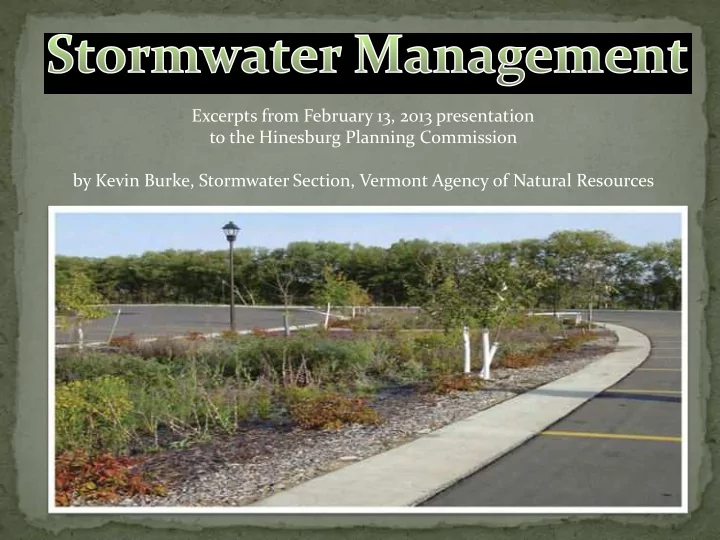

!"#$%&'()*%+,)-$.%/0%1)234)5623)&%$($7'0'8+7 '+)'9$):87$(./%;)<=07787;)>+,,8((8+7 .1)?$@87)A/%B$4)C'+%,D0'$% C$#'8+74)E$%,+7')F;$7#1)+*)G0'/%0=)H$(+/%#$(
PROS CONS • Generally simple design • Practice does not meet Groundwater (initially less design cost Recharge and does not encourage form most consultants) infiltration and/or runoff reduction • Impounded water is likely to warm and • Can be designed to meet may result in additional temperature WQ, CPv, Qp10, Qp100 impacts to cold water habitat downstream. • Adaptable to most • Costly construction development projects • Aesthetic impacts depending on location, landscaping, maintenance • End of pipe treatment • Takes up a lot of space !"!#$%&'&()*+)+%&"$,+&%-%!"!#$%(."&(."/'& Median Removal Efficiency (%) TSS = 80 TP = 52
PROS CONS • More aesthetically pleasing • Practice does not meet Groundwater than basic wet pond. Recharge and does not encourage • Provides habitat for wildlife infiltration and/or runoff reduction • Can be designed to meet • Impounded water is likely to warm and WQ, and in some cases with may result in additional temperature detention, CPv, Qp10, Qp100 impacts to cold water habitat • Adaptable to most downstream, depending on design. development projects • Costly construction • May be appropriate in areas • End of pipe treatment adjacent to existing • Takes up a significant amount of space wetlands. • Requires more design time by consultant driving up design cost. !"!#$%&'&()*+)+%&"$,+&%-%!"!#$%(."&(."/'& Median Removal Efficiency (%) TSS = 72 TP = 48
PROS CONS • Costly construction • Standing water for limited period of depending on design time, not impounded/no warm water • End of pipe treatment in discharge. some cases • Can be designed to meet WQ and • Can take up a significant Groundwater Recharge, and in some amount of space if above cases with good infiltration rates and/or ground overflow, CPv, Qp10, Qp100 • Requires more design • Adaptable to most development time by consultant driving projects with infiltrative soils. up design cost; infiltration • Significantly reduces runoff leaving tests etc. the site – Runoff Reduction • Limited to sites with • Can be designed on surface or appropriate soil conditions. underground; basins, trenches, • Not appropriate at “hot drywells. spots” • More potential for managing !"!#$%&'&()*+)+%&"$,+&%-%!"!#$%(."&(."/'& stormwater runoff at the source – LID. Median Removal Efficiency (%) TSS = 89 TP = 65
PROS CONS • More costly construction • Standing water for limited period of depending on design time, not impounded/no warm water • End of pipe treatment in discharge. some cases • Aesthetically pleasing designs which • Can take up a significant also encourage maintenance amount of space if above • Can be designed to meet WQ and in ground and designed for some cases with good infiltration rates large drainage area. and/or overflow, Groundwater • May require more design Recharge, CPv, Qp10, Qp100 time initially by unfamiliar • Adaptable to most development consultant driving up projects with both infiltrative and non- design cost; infiltration infiltrative soils. tests etc. • Significantly reduces runoff leaving the site – Runoff Reduction • More potential for managing !"!#$%&'&()*+)+%&"$,+&%-%!"!#$%(."&(."/'& stormwater runoff at the source – LID. Median Removal Efficiency (%) TSS = 59 TP = 5
PROS CONS • Generally simple design, with creative • End of pipe stormwater applications management • Standing water for limited period of • Can take up a significant time, not impounded/no warm water amount of space if above discharge. ground and designed for • Utilized to provide CPv, Qp10, Qp100 large drainage area. • Adaptable to most development • Does not provide for WQ projects with both infiltrative and non- or Groundwater Recharge infiltrative soils; underground storage. treatment • Can manage stormwater for large • Aesthetics drainage areas or small drainage areas. • Can be combined with WQ treatment practices and WQ/Recharge credits for minimizing structural footprints. • Dry detention areas can often be multi- !"!#$%&'&()*+)+%&"$,+&%-%!"!#$%(."&(."/'& purpose (i.e. recreational area/open Median Removal Efficiency (%) space). TSS = 49 TP = 20
PROS CONS • Standing water for limited period of • End of pipe stormwater time, not impounded/no warm water management discharge. • Can take up a significant • Adaptable to most development amount of space if above projects with both infiltrative and non- ground and designed for infiltrative soils; underground storage. large drainage area. • Can be combined with underground • Does not provide for CPv, storage/treatment for minimizing Qp10, or Qp100 structural footprints. • Aesthetics • Can be costly !"!#$%&'&()*+)+%&"$,+&%-%!"!#$%(."&(."/'& Median Removal Efficiency (%) TSS = 86 TP = 59
PROS CONS • Limited standing water, dry structures • Most designs do not not impounded/no warm water provide for CPv, Qp10, or discharge. Qp100 • Adaptable to most development • Aesthetics – “ditch” projects with both infiltrative and non- • Many designs may infiltrative soils. provide limited treatment • Can be designed as wet or dry structures and vegetated for aesthetically pleasing results. • Can be combined with underground storage/treatment or dry detention for minimizing structural footprints. • Can be designed for infiltration • Can eliminate the need for “curb/gutter” !"!#$%&'&()*+)+%&"$,+&%-%!"!#$%(."&(."/'& • Cost effective Median Removal Efficiency (%) TSS = 81 TP = 24
PROS CONS • Runoff Reduction, resulting in overall • Most designs do not pollutant load reduction. provide for CPv, Qp10, or • Manages stormwater runoff at the Qp100 source • Aesthetics • Reuse provides additional benefits • Many designs may • Green roofs may reduce energy costs provide limited treatment • Aesthetics • Rain harvesting does not • Pervious pavers, concrete, asphalt in currently meet state WQ or most cases depending on design, is not detention standards. state jurisdictional impervious surface – • Often requires a change and may not require permit. in human behavior, making it difficult to implement
Recommend
More recommend